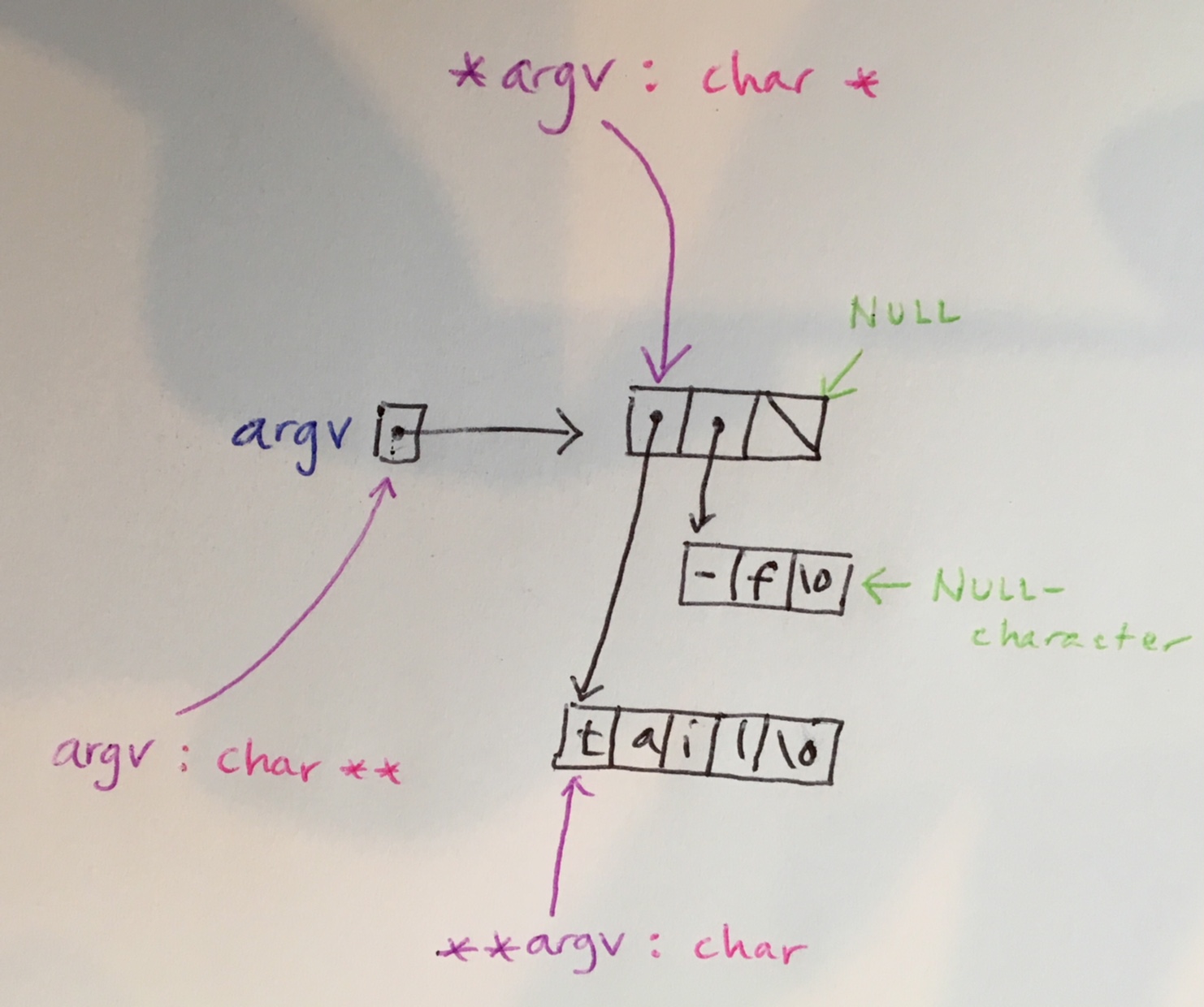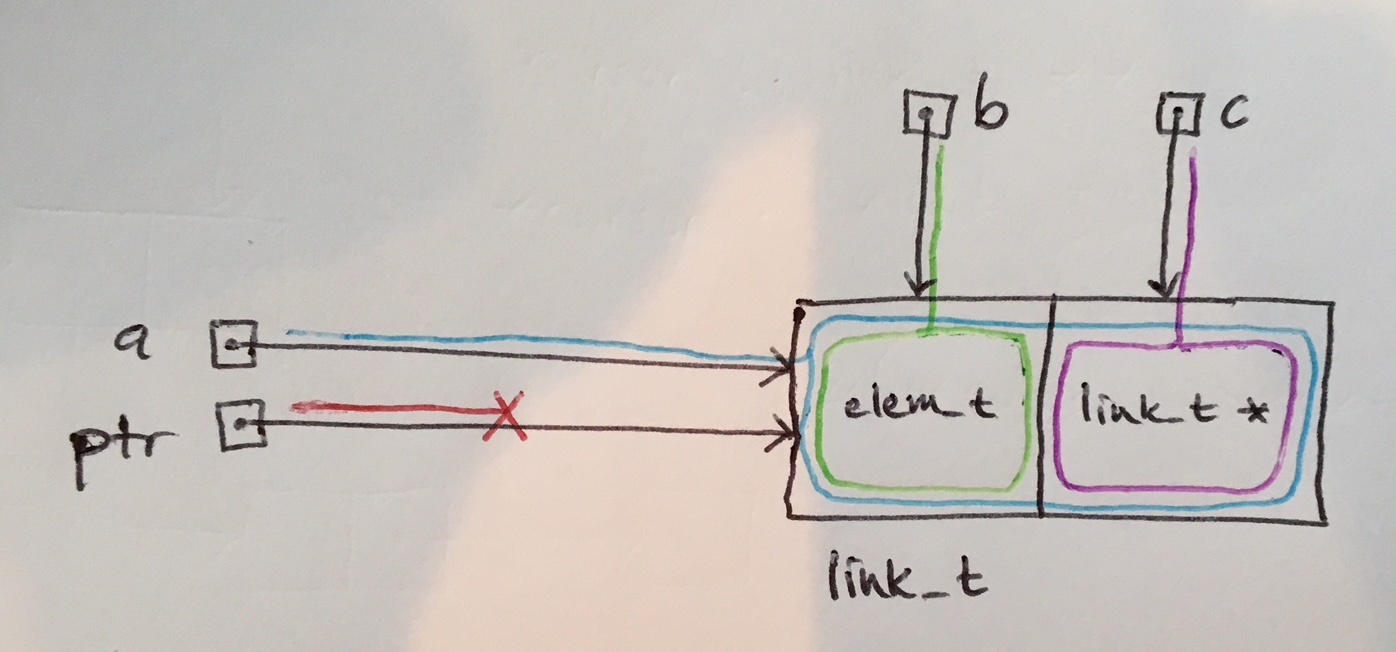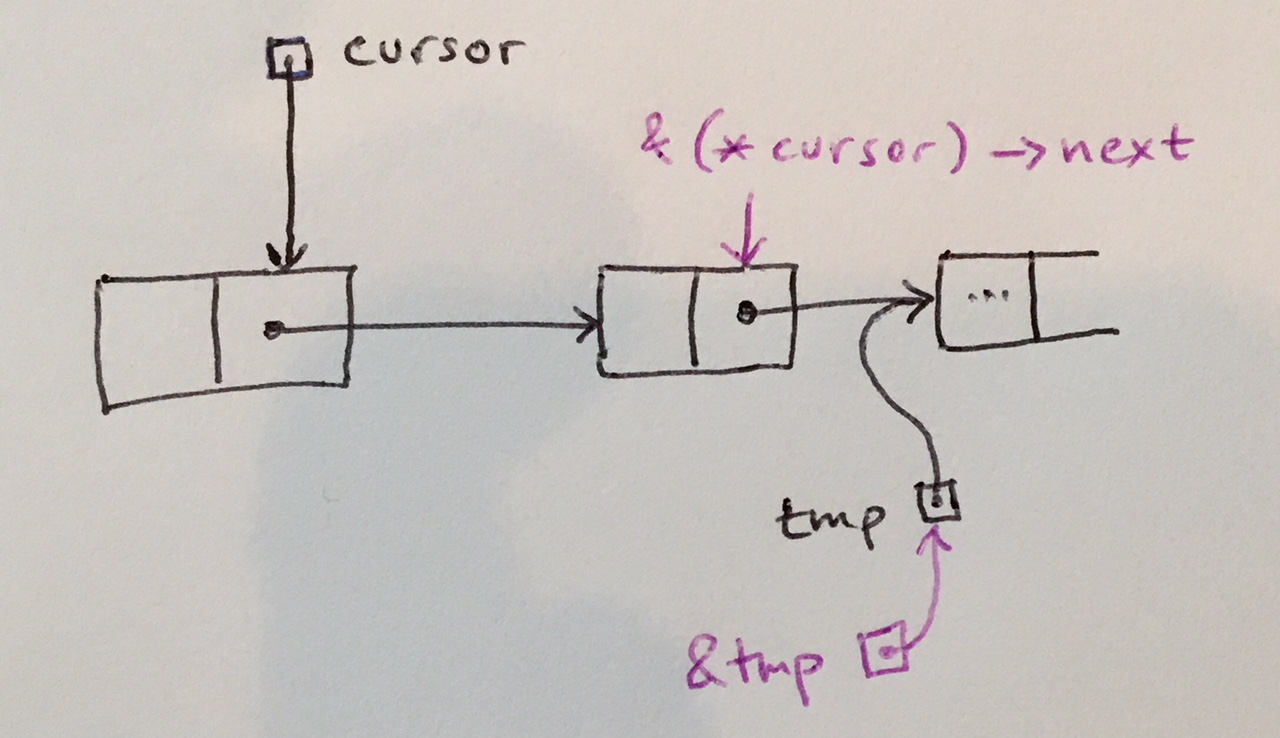Pointers
Table of Contents
1 Pointers
Pointers were invented by Harold W. Lawson in 1964–65 in the context of the PL/I programming language. In 2000, he received the IEEE Computer Pioneer Award for this.
A pointer in C is an address to a place in memory where there
may or may not be some accessible data. Pointers are offsets into
the array of bytes that is the memory, and so could technically be
integers, but we are usually not interested in the value of the
pointer (i.e., the address of a location), but the value stored
at that location. In C, the type of a pointer to a location
holding a value of type T is written T *. Here are some pointer
types and their interpretation:
| Type | Interpretation |
|---|---|
int |
an integer value |
int * |
a pointer to (a place in memory holding) an int |
int ** |
a pointer to place in memory that holds a pointer to an int |
void * |
a pointer to a data of unknown type |
By convention, we write variable declarations of pointer type thus:
int *iptr; /// pointer to an int (note where the * goes!)
int%20%2Aiptr%3B%20%2F%2F%2F%20pointer%20to%20an%20int%20%28note%20where%20the%20%2A%20goes%21%29%0A
Given the above declaration, an iptr is a pointer variable,
i.e., a variable that holds a location to a place in memory.
Furthermore, at that place in memory, a value of type int is
stored.
To take the address of something, we use the & operator
(address-of). The following code declares a variable x that
holds the value 42 (an int) and another variable iptr that
holds a location in memory – the address of the x variable,
written &x.
int x = 42; int *iptr = &x;
int%20x%20%3D%2042%3B%20%0Aint%20%2Aiptr%20%3D%20%26x%3B%0A
The type of iptr is int * (pointer to an int). To get to the
actual int value, we must dereference it using the *
operator (dereference). The type of *iptr is thus int not
int *. Furthermore, the value of *iptr is 42, and it is the
very same value as stored in x. Thus, if we change x like so
x = 43 – the new value is also visible through *iptr. And
conversely, *iptr = 44 changes the value of x (but not the
value of iptr – it still points to the same location in memory,
even though the value at this location has changed).
Every time you take the address of something, you add a level of indirection. Whenever you dereference something, you move closer to some concrete value.
Using & and * works very much like balancing an equation \(e:t\)
where \(e\) is some expression and \(t\) is a type:
- (take address) Adding
&on the left-hand side of the \(:\) adds a corresponding*on the right-hand side. - (dereference) Adding
*on the left-hand side of the \(:\) removes a corresponding*on the right-hand side.
You cannot add more than one & operator: &&x is never well-defined
because the result of the first &x has not yet been stored in a
place that has a location that we can take using another &.
A classic mistake when programming with references is writing
e.g., int *x = 42, thinking that this creates a pointer variable
x that stores some unknown location where the integer 42 is
stored. This is not the case! This creates a pointer variable x
that stores the location 42, where an unknown value is stored.
If you really need an unknown location, create it using malloc():
int *x = malloc(sizeof(int)); and then *x = 42. Now, x really
points to some location (as returned by malloc()) that stores the
integer value 42.
1.1 Pointers are Powerful
Pointers lets us share data. Instead of passing in a copy of a value to a function, I can share the value with the function. No matter the size of the value – hundreds of bytes to gigabytes – its address still fits in 8 bytes (on a 64 bit machine), so that way of sharing is clearly more efficient.
In C, pointers allow us to define recursive data structures
because implicit in each pointer value is its possibility of being
NULL, i.e., the absence of the location of some value.
1.2 Pointers are Dangerous
The main problem with pointers surface when you use them to share mutable state. This is a typical C pattern, but one that must be handled with care. The most subtle problems happen when two or more “agents” unknowingly shares a common value via pointers. A simple example:
void example(int *a, int *b) { *a = 42; *b = 4711; }
void%20example%28int%20%2Aa%2C%20int%20%2Ab%29%0A%7B%0A%20%20%2Aa%20%3D%2042%3B%0A%20%20%2Ab%20%3D%204711%3B%0A%7D%0A
If example() happens to get called with the same pointer as both
a and b, the second update will overwrite the first! This might
come as a surprise!
Furthermore, pointers in combination with malloc() needs to be
freed using free(). However, in many programs it can be very
hard to figure out e.g.,
- Who is responsible for freeing something?
- When is it safe to free something? (What if it is shared!?)
Not freeing causes the program to leak memory. Freeing more than once usually causes the program to explode.
Last, a pointer is just an address which is in no way connected to the value it points to. For example, I can do this:
int *x = ...; free(x); printf("x: %d\n", *x); *x = 42;
int%20%2Ax%20%3D%20...%3B%0Afree%28x%29%3B%0Aprintf%28%22x%3A%20%25d%5Cn%22%2C%20%2Ax%29%3B%0A%2Ax%20%3D%2042%3B%0A
This code accesses x twice after it is freed: once to
dereference it and read its value, and once to dereference and
update the value. Neither is legal after the free() call! After
the free() call, x holds a dangling pointer which must never
be referenced. A defensive programming technique is to always set
a varialble you have free()’d to NULL so that accesses
segfault rather than live on for some part of some program!
Throughout the course, we will see examples of when pointers are both great and cause all kinds of problems.
2 An Extra Level of Indirection: Pointers to Pointer Values
Historically, pointers has been a hard concept to grasp, and pointers to pointers therefore logically must be exponentially hard?
Actually not. You have probably written many programs that used
this concept. For example, char *argv[] is an array holding
pointers – and char **argv is an equivalent type. Dereferencing
argv means reading a location in memory where a pointer – in
this case to a null-terminated string – resides. Let us examine
argv and its dereferencing.
argv |
An address to a place in memory storing an address to a place in memory storing a char (pointer-to-pointer) |
*argv |
An address to a place in memory storing a char (pointer) |
**argv |
A char (value) |
To concretise this, Figure 1 shows the argument vector
argv of a program called tail invoked with the single
command-line argument -f. Purple arrows shows the value of the
purple expressions. The types of each purple expression is written
out in pink.

Figure 1: What argv looks like in a program run as tail -f
In this document, we will look at pointers to pointers and their use. We will look at linked lists as our driving example, because we know them well from previous “modules” in this course.
2.1 Pointers Into Structures
To grasp the use of pointers to pointers in the upcoming example,
we must first talk about pointers into structures. Commonly,
malloc() and calloc()1
allocate some consecutive bytes on the heap and return a pointer
to the “start” of this structure. For example, remember the
link structure from before.
typedef struct link link_t; struct link { elem_t elem; link_t *next; };
typedef%20struct%20link%20link_t%3B%20%0Astruct%20link%20%0A%7B%0A%20%20elem_t%20elem%3B%20%0A%20%20link_t%20%2Anext%3B%0A%7D%3B%0A
Executing ptr = malloc(sizeof(link_t)) makes ptr a pointer to
the start of some space large enough to hold at least a
link_t. Given the layout of the link_t struct, we can see that
first in the struct is an elem_t followed by a pointer to a
link_t. So, since the first field in a struct is at the
beginning of the struct, the address denoted by ptr, not only
could ptr be typed as a pointer to a link_t, but also as a
pointer to an elem_t (and both at the same time). In a similar
fashion, we can get a pointer to the second field, whose type is
link_t *. Let’s write some code to make this concrete:
void *ptr = malloc(sizeof(link_t)); link_t *a = ptr; elem_t *b = ptr; link_t **c = ptr + offsetof(link_t, next);
void%20%2Aptr%20%3D%20malloc%28sizeof%28link_t%29%29%3B%20%0Alink_t%20%2Aa%20%3D%20ptr%3B%0Aelem_t%20%2Ab%20%3D%20ptr%3B%0Alink_t%20%2A%2Ac%20%3D%20ptr%20%2B%20offsetof%28link_t%2C%20next%29%3B%0A
Above, ptr, a and b are aliases, and allow us to access the
same memory as different types. Let’s refer to ptr as the
address of the place in memory where the link_t struct is
defined. Through b, we are allowed to access the memory at ptr
to read and write in elem_t-sized chunks2, because that’s what the
type says is found at b. Similarly, through a, we are allowed
read and write accesses in link_t-sized chunks3.
Figure 2 illustrates the code above. The coloured line on
each black pointer shows what part of the structure can be read
through that pointer. Note that the void pointer cannot be
dereferenced, meaning it cannot be used to read the structure at
all.

Figure 2: Accessing (parts of) the same structure through different pointers
The macro offsetof() allows us to calculate the relative
starting address in memory of a field in a struct.4 On the machine where this is written,
offsetof(link_t, next) is 8. Thus the addressed stored in c
is ptr + 8. Note that this address is inside the struct pointed
to by a, that is a < c < a + sizeof(*a).
Because c is a pointer to a field in a struct that stores a
pointer, c is a pointer to a pointer, which is clearly
reflected by its type: link_t **. Thus, c denotes an address
in memory5 where a pointer is stored. In the code example above,
the value of this pointer is undefined, because we used
malloc(). Dereferencing this pointer – aka following this
pointer to read the memory at the location it points to – *c,
denotes an address in memory where a pointer to a link_t is
stored. We may dereference this pointer too, adding another * to
the expression: **c denotes a value of type link_t. In
summary:
| Expression | Type |
c |
link_t ** |
*c |
link_t * |
**c |
link_t |
***c |
illegal, link_t is not a pointer |
&c |
link_t *** |
This clearly shows how the number of *’s are “balanced” – to get
closer to the value, add another star in front of the expression.
Taking the address using & adds a * to the type, reflecting
the additional pointer indirection. The number of *’s in the type
of some variable x upper bounds how many times we can dereference
x, i.e., write *x, **x, etc.
Above, c exemplifies a pointer into a structure.
Pointers to pointers can often simplify implementations by making things more regular, and getting rid of corner cases.
2.2 Using Pointers-to-Pointers to Implement Unlinking
When we implemented linked lists, we used a clever trick of inserting a sentinel link at the start of the node to simplify the implementation. This allowed us to define a find function that returned the preceding node. This allowed the find function to be used across multiple list functions such as insert, remove, and get.
We will now see how we can implement a similar function but
without the need for a sentinel. The trick is to return a
pointer – not to a link, but to a pointer to a link. Such a
pointer can be used both for reading and writing, allowing its use
across multiple list functions such as insert, remove, and get,
like before. Because a link_t * can be found both in the next
fields of links and in the first and last fields of lists,
a link_t ** can cover both these cases. Thus, there is no need
for a sentinel link to be able to easily update the pointer
to a link.
static link_t **list_find(list_t *list, int index) { link_t **cursor = &list->first; for (int i = 0; i < index && *cursor; ++i) { cursor = &(*cursor)->next; } return cursor; }
static%20%0Alink_t%20%2A%2Alist_find%28list_t%20%2Alist%2C%20int%20index%29%0A%7B%0A%20%20link_t%20%2A%2Acursor%20%3D%20%26list-%3Efirst%3B%0A%0A%20%20for%20%28int%20i%20%3D%200%3B%20i%20%3C%20index%20%26%26%20%2Acursor%3B%20%2B%2Bi%29%0A%20%20%20%20%7B%0A%20%20%20%20%20%20cursor%20%3D%20%26%28%2Acursor%29-%3Enext%3B%0A%20%20%20%20%7D%0A%0A%20%20return%20cursor%3B%20%0A%7D%0A
We start by defining cursor – a pointer to a pointer – by
taking the address of list->first using the & operator. Like
we saw in the table above, list->first is a link_t * but
&list->first is a link_t **. This pointer points to the first
field in the list struct. Thus, even if an empty list is
represented as a list whose first and last fields are both
NULL, &list->first is defined, and not NULL6. Figure 3 shows the
value of cursor after the first line of list_find() is
executed.

Figure 3: The value of cursor at the start of a find
As is visible from the code, swinging cursor forward through the
list is somewhat involved. Previous iteration in the list
implementation used code like cursor = cursor->next. Now, we are
forced to dereference cursor to read next and then take the
address of the result: cursor = &(*cursor)->next.
In plain English what this means is: read the address of the
variable cursor, then take the address of the next field
of the object stored at that location, and store the result in
cursor.
Note that turning this operation into two discrete steps is not
possible. Consider declaring a temporary variable tmp to store
the value of the next field, and then using &tmp to swing
cursor forward. When list_find() returns, its will return a
pointer to a variable (tmp) located on the stack frame that is
just popped!
link_t *tmp = (*cursor)->next; cursor = &tmp; ... return cursor;
link_t%20%2Atmp%20%3D%20%28%2Acursor%29-%3Enext%3B%0Acursor%20%3D%20%26tmp%3B%0A...%0Areturn%20cursor%3B%0A
In plain English what the first line means is: read the address
of the variable cursor, then read the value of the next
field of the object stored at that location, and store the result
in tmp. The interpretation of the 2nd line: take the address
of the local variable tmp and store that address in cursor.
Figure 4 shows the difference between
&(*cursor)->next and &tmp pictorially.

Figure 4: Illustrating the difference between &(*cursor)->next and &tmp
Even if the stack frame is not overwritten by a subsequent
function call, *cursor = new_link() will only update the
(useless) value of tmp, a variable on a popped stack frame.
Using the list_find() function is very similar to how we used
list_find() in the past, except that we use *cursor both to
read and write the field that cursor points to7.
void list_insert(list_t *list, int index, elem_t element) { link_t **cursor = list_find(list, index); if (*cursor) { *cursor = link_new(element, *cursor); } }
void%20list_insert%28list_t%20%2Alist%2C%20int%20index%2C%20elem_t%20element%29%0A%7B%0A%20%20link_t%20%2A%2Acursor%20%3D%20list_find%28list%2C%20index%29%3B%0A%0A%20%20if%20%28%2Acursor%29%0A%20%20%20%20%7B%0A%20%20%20%20%20%20%2Acursor%20%3D%20link_new%28element%2C%20%2Acursor%29%3B%20%0A%20%20%20%20%7D%0A%7D%0A
2.3 Application to Trees
Above, we iterated over a list by pointing to the pointer to the
next link_t in the list. This allows us to very easily implement
functions that insert or unlink a specific link.
This is even more powerful when it comes to less linear data structures. For example, when navigating a binary search tree, it is useful to keep a pointer to the parent pointer’s pointer to a subtree instead of simply the pointer to a subtree. This allows us to navigate to the subtree, but also update it, without caring whether the pointer is the left or right subtree.
static node_t **tree_inner_find_node(node_t **n, elem_t e) { node_t **cursor = n; while (*cursor) { /// Logic left as exercise to the reader (no recursion!) } return cursor; }
static%0Anode_t%20%2A%2Atree_inner_find_node%28node_t%20%2A%2An%2C%20elem_t%20e%29%0A%7B%0A%20%20node_t%20%2A%2Acursor%20%3D%20n%3B%0A%0A%20%20while%20%28%2Acursor%29%0A%20%20%20%20%7B%0A%20%20%20%20%20%20%2F%2F%2F%20Logic%20left%20as%20exercise%20to%20the%20reader%20%28no%20recursion%21%29%0A%20%20%20%20%7D%0A%0A%20%20return%20cursor%3B%0A%7D%0A
With this code, we can now in an easy way implement insertion. We
simply obtain a pointer to the pointer to the place in the tree
where we should add the new node. Let n be this pointer.
Below, if *n is NULL we “fell out of the tree” going down some
subtree where we expected to the key. In that case, we simply
create a new subtree and update *n to point to that subtree
instead of NULL.
bool tree_insert(tree_t *t, key_t k, elem_t e) { node_t **n = tree_inner_find_node(t->root); if (*n) { *n = node_new(k, e, NULL, NULL); } }
bool%20tree_insert%28tree_t%20%2At%2C%20key_t%20k%2C%20elem_t%20e%29%0A%7B%0A%20%20node_t%20%2A%2An%20%3D%20tree_inner_find_node%28t-%3Eroot%29%3B%20%0A%0A%20%20if%20%28%2An%29%0A%20%20%20%20%7B%0A%20%20%20%20%20%20%2An%20%3D%20node_new%28k%2C%20e%2C%20NULL%2C%20NULL%29%3B%20%0A%20%20%20%20%7D%0A%7D%0A
2.4 Recap
Pointers to values allows values to be shared across several places in the code such that a modification from one part becomes visible to another. Since pointers are just a form of value, a pointer to another pointer follows no special rules that do not apply to, say, a pointer to an integer.
In linked structures, having a pointer to a next field instead
of the value in that next field is often convenient, because
that same pointer will allow you to both get the contents of the
next field and set the contents. For a linked list, this is
similar to having a pointer to the preceding link, but for a
tree-shaped data structure, there is no “clean” alternative.
Questions about stuff on these pages? Use our Piazza forum.
Want to report a bug? Please place an issue here. Pull requests are graciously accepted (hint, hint).
Nerd fact: These pages are generated using org-mode in Emacs, a modified ReadTheOrg template, and a bunch of scripts.
Ended up here randomly? These are the pages for a one-semester course at 67% speed on imperative and object-oriented programming at the department of Information Technology at Uppsala University, ran by Tobias Wrigstad.
Footnotes:
realloc() and others.elem_t, e.g., p.link_t, e.g., next.offsetof(T, f) is calculated as &((T)NULL)->f. Note how
this is defined even though this looks like a NULL dereference
at first glance.ptr + 8 on the machine where this is
written.NULL pointer is
stored exists somewhere in memory.*cursor.